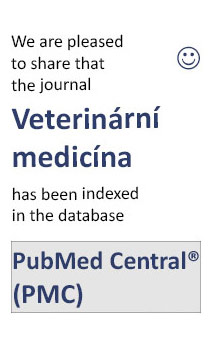Journal of Veterinary Medicine indexed in PubMed Central® database!
We are pleased to share that the Veterinární Medicína journal has successfully met the criteria of scientific and technical quality and has been indexed in PubMed Central® (PMC), a major medical database operated by the National Library of Medicine (NIH/NLM) at the U.S. National Institutes of Health.
Veterinární Medicína articles will now be available to thousands more scientists, students, and educators from around the world.
Articles from Veterinární Medicína at PMC can be found at: https://www.ncbi.nlm.nih.gov/pmc/journals/4436/.
The Czech Academy of Agricultural Science, the publisher of the Vetarinární medicína thanks all the members of the Editorial Board for their tireless work for the journal, to the authors for their quality articles and to the reviewers for their thorough reviews.
Veterinární medicína – veterinary medicine journal
- ISSN 0375-8427 (Print)
- ISSN 1805-9392 (On-line)
An international open access peer-reviewed journal published by the Czech Academy of Agricultural Sciences and financed by the Ministry of Agriculture of the Czech Republic
- The journal is administered by an international Editorial Board
- Published since 1956
- Editor-in-Chief: prof. MVDr. Miroslav Toman CSc.
- Co-Editors: prof. MVDr. Eva Baranyiová, CSc.; doc. Mgr. MVDr. Leoš Landa, Ph.D.; doc. MVDr. Pavel Suchý, Ph.D.; doc. MVDr. Michal Vlašín, Ph.D. ECVS, MRCVS; prof. MVDr. Dagmar Zendulková, CSc.
- Executive Editor: Bc. Adéla Zvěřinová, MSc.
- Technical Editor: Ing. Helena Smolová, Ph.D.
- The journal is published monthly
Aims & Scope
The journal Veterinarni Medicina publishes original papers, short communications, critical reviews and case reports from all fields of veterinary and biomedical sciences.
Current issue
Epidemiological insights into bovine helminthiasis in Upper Egypt: Prevalence, risk factors, and pathological findingsOriginal Paper
AA Khedr, SM AbdelRaheem, MM Farghaly, SI Alsultan, M Abdulmohsen, S Fathi El-Hawari, WG El-Dein Mahmoud
Vet Med - Czech, 2025, 70(10):339-357 | DOI: 10.17221/112/2024-VETMED 
This study examines the prevalence of helminthic infestations, risk factors, and odds ratios in 1 300 cattle, revealing significant patterns in parasite distribution and influencing factors. Overall, 60.3% of cattle were infested with one or more types of parasites, with Moniezia spp. being the most prevalent (46.9%), followed by Fasciola spp. (36.9%), Paramphistomum spp. (26.8%), and Avitellina spp. (10.8%). Among the seasons, winter exhibited the highest infestation rate (66.1%), and calves under one year of age were more commonly infested (64.2%) than older cattle (over three years: 51.1%, OR = 0.584 1). Distinct...
Effect of trace mineral injection on serum trace mineral concentrations and reproductive indicators in sheep synchronised during the anoestrus periodOriginal Paper
A Cortu, O Gungor
Vet Med - Czech, 2025, 70(10):358-368 | DOI: 10.17221/28/2025-VETMED 
Sheep production represents an important source of income for farmers in Türkiye; however, reproductive inefficiencies during the anoestrus period pose a major challenge to productivity. This study aimed to evaluate the effects of injectable trace minerals (copper, selenium, manganese, and zinc) on the reproductive performance of Awassi ewes synchronised during the anoestrous period. A total of 200 clinically healthy ewes were randomly allocated to two groups: the trace mineral group (TRACE, n = 100), which received 2 ml of a trace mineral solution 14 days before oestrus synchronisation, and the control group (CON, n = 100), which received...
Prevalence of lumbosacral transitional vertebrae and association with hip dysplasia in Rhodesian Ridgebacks in GermanyOriginal Paper
SK Slunsky, P Slunsky, E Fort, L Brunnberg
Vet Med - Czech, 2025, 70(10):369-378 | DOI: 10.17221/30/2025-VETMED 
Congenital anomalies affecting the spinal column are frequently observed in certain dog breeds. One such condition occurs at the junction between the lower back and the sacrum, where vertebrae exhibit mixed structural characteristics. This retrospective study analysed imaging records of Rhodesian Ridgebacks collected over 28 years, selecting only those that met strict positioning standards for evaluation. A total of 2 012 cases were analysed using established classification methods, identifying three distinct structural variations: a typical junction, a bilaterally altered morphology, and an asymmetrical form affecting one side. The prevalence...
The effects of zinc oxide nanoparticles on the oxidative stress, caspase-3, cytokine and immunity in ratsOriginal Paper
M Gultekin, M Eren, FD Koca, CK Bozbek, N Develi
Vet Med - Czech, 2025, 70(10):379-392 | DOI: 10.17221/11/2025-VETMED 
This study was conducted to examine the effects of zinc oxide nanoparticles (ZnO NPs) on the malondialdehyde (MDA) concentrations, superoxidase dismutase (SOD), glutathione peroxidase (GPx) and caspase-3 (CASP3) activities, tumour necrosis factor-alpha (TNF-α) and interleukin-6 (IL-6), immunoglobulin (Ig) E, G, M and zinc (Zn) concentrations in the serum/plasma and liver tissues of rats. Forty Wistar Albino rats were separated into five equal groups as the control, 5 and 10 mg/kg, b.w./day ZnO, 5 and 10 mg/kg b.w./day ZnO NPs were administered i.p. every other day for 14 days. The plasma MDA and plasma/liver TNF-α concentrations increased...


